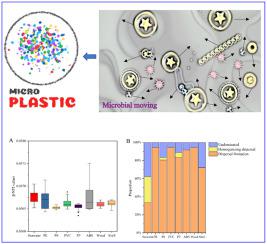Journal of Hazardous Materials ( IF 13.6 ) Pub Date : 2021-07-30 , DOI: 10.1016/j.jhazmat.2021.126780 Sheng-Jie Zhang 1 , Yan-Hua Zeng 1 , Jian-Ming Zhu 1 , Zhong-Hua Cai 2 , Jin Zhou 2

|
The microbial colonization profiles on microplastics (MPs) in marine environments have recently sparked global interest. However, many studies have characterized plastisphere microbiomes without considering the ecological processes that underly microbiome assembly. Here, we carried out a three-timepoint exposure experiment at 1-, 4-, and 8-week and investigated the colonization dynamics for polyethylene, polypropylene, polystyrene, polyvinyl chloride, and acrylonitrile-butadiene-styrene MP pellets in natural coastal water. Using high-throughput sequencing of 16S rRNA, we found diversity and evenness were higher (p < 0.05) in the plastisphere communities than those in seawater, and microorganisms colonizing were co-influenced by environmental factors, polymer types, and exposure duration. Functional potential and co-occurrence network analysis revealed that MP exposure enriched the xenobiotic biodegradation potential and reduced the complexity of the MP microbial network. Simultaneously, null-model analyses indicated that stochastic processes contributed a bigger role than deterministic processes in shaping plastisphere microbial community structure with dispersal limitations contributing to a greater extent to microbial succession trajectories. These results implied the plastic surface had a more important role as a raft onto which microbes attach rather than selectively recruiting plastic-specific microbial colonizers. Our work strengthened the understanding of the ecological mechanisms by which microbial community patterns are controlled during colonization by plastic-associated microbes.
中文翻译:

自然海洋环境中塑料圈微生物群落的结构和组装机制
海洋环境中微塑料 (MPs) 的微生物定植概况最近引起了全球的兴趣。然而,许多研究在没有考虑微生物组组装基础的生态过程的情况下描述了塑料球微生物组的特征。在这里,我们在 1 周、4 周和 8 周进行了三个时间点的暴露实验,并研究了天然沿海水中聚乙烯、聚丙烯、聚苯乙烯、聚氯乙烯和丙烯腈-丁二烯-苯乙烯 MP 颗粒的定植动态。使用 16S rRNA 的高通量测序,我们发现塑料圈群落中的多样性和均匀度高于海水中的多样性和均匀度(p < 0.05),并且微生物定植受环境因素、聚合物类型和暴露时间的共同影响。功能潜力和共生网络分析表明,MP 暴露丰富了异生物质的生物降解潜力,并降低了 MP 微生物网络的复杂性。同时,零模型分析表明,随机过程比确定性过程在塑造塑料圈微生物群落结构方面的作用更大,而扩散限制对微生物演替轨迹的影响更大。这些结果表明塑料表面作为一个筏子扮演着更重要的角色,微生物附着在它上面,而不是选择性地招募塑料特定的微生物定植者。我们的工作加强了对微生物群落模式在塑料相关微生物定殖过程中控制的生态机制的理解。


























 京公网安备 11010802027423号
京公网安备 11010802027423号